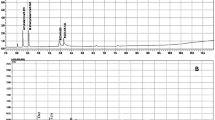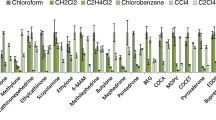Abstract
This study aimed to determine simultaneously five major street cocaine adulterants (caffeine, lidocaine, phenacetin, diltiazem, and hydroxyzine) in human urine by dispersive liquid-liquid microextraction (DLLME) and high-performance liquid chromatography. The chromatographic separation was obtained in gradient elution mode using methanol:water plus trifluoroacetic acid 0.15% (v/v) (pH = 1.9) at 1 mL min−1 as mobile phase, at 25 °C, detection at 235 nm, and analysis time of 20 min. The effect of major DLLME operating parameters on extraction efficiency was explored using the multifactorial experimental design approach. The optimum extraction condition was set as 4 mL human urine sample alkalized with 0.5 M sodium phosphate buffer (pH 12), NaCl (15%, m/v), 300 μL acetonitrile (dispersive solvent), and 800 μL chloroform (extraction solvent). Linear response (r2 ≥ 0.99) was obtained in the range of 180–1500 ng mL−1 with suitable selectivity, quantification limit (180 ng mL−1), mean recoveries (33.43–76.63%), and showing relative standard deviation and error (within and between-day assays) ≤15%. The analytes were stable after a freeze-thaw cycle and a short-term room temperature stability test. This method was successfully applied in real samples of cocaine users, suggesting that our study may contribute to the appropriate treatment of cocaine dependence or with the cases of cocaine acute intoxication.





Similar content being viewed by others
References
Kurowska-Susdorf A, Zwierzdzynski M, Bevanda AM, Talic S, Ivankovic A, Płotka-Wasylka J. Green analytical chemistry: social dimension and teaching. Trends Anal Chem. 2019;111:185–96. https://doi.org/10.1016/j.trac.2018.10.022.
Filippou O, Bitas D, Samanidou V. Green approaches in sample preparation of bioanalytical samples prior to chromatographic analysis. J Chromatogr B. 2017;1043:44–62. https://doi.org/10.1016/j.jchromb.2016.08.040.
Rezaee M, Assadi Y, Hosseini MRM, Aghaee E, Ahmadi F, Berijani S. Determination of organic compounds in water using dispersive liquid-liquid microextraction. J Chromatogr A. 2006;1116:1–9. https://doi.org/10.1016/j.chroma.2006.03.007.
Arthur CL, Pawliszyn J. Solid phase microextraction with thermal desorption using fused silica optical fibers. Anal Chem. 1990;62:2145–8. https://doi.org/10.1021/ac00218a019.
de Santana FJM, Bonato PS. Enantioselective analysis of mirtazapine and its two major metabolites in human plasma by liquid chromatography–mass spectrometry after three-phase liquid-phase microextraction. Anal Chim Acta. 2008;606:80–91. https://doi.org/10.1016/j.aca.2007.10.037.
Primel EG, Caldas SS, Marube LC, Escarrone ALV. An overview of advances in dispersive liquid-liquid microextraction for the extraction of pesticides and emerging contaminants from environmental samples. Trends Environ Anal Chem. 2017;14:1–18. https://doi.org/10.1016/j.teac.2017.03.001.
Al-Saidi HM, Emara AAA. The recent developments in dispersive liquid-liquid microextraction for preconcentration and determination of inorganic analytes. J Saudi Chem Soc. 2014;18(6):745–61. https://doi.org/10.1016/j.jscs.2011.11.005.
Viñas P, Campillo N, López-García I, Hernández-Córdoba M. Dispersive liquid-liquid microextraction in food analysis. A critical review. Anal Bioanal Chem. 2014;406(8):2067–99. https://doi.org/10.1007/s00216-013-7344-9.
Mansour FR, Khairy MA. Pharmaceutical and biomedical applications of dispersive liquid-liquid microextraction. J Chromatogr B Anal Technol Biomed Life Sci. 2017;1061-1062:382–91. https://doi.org/10.1016/j.jchromb.2017.07.055.
Viñas P, Campillo N, Pastor-Belda M, Oller A, Hernández-Córdoba M. Determination of phthalate esters in cleaning and personal care products by dispersive liquid-liquid microextraction and liquid chromatography-tandem mass spectrometry. J Chromatogr A. 2015;1376:18–25. https://doi.org/10.1016/j.chroma.2014.12.012.
Zuloaga O, Olivares M, Navarro P, Vallejo A, Prieto A. Dispersive liquid-liquid microextraction: trends in the analysis of biological samples. Bioanalysis. 2015;7(17):2211–25. https://doi.org/10.4155/bio.15.141.
Fisichella M, Odoardi S, Strano-Rossi S. High-throughput dispersive liquid/liquid microextraction (DLLME) method for the rapid determination of drugs of abuse, benzodiazepines and other psychotropic medications in blood samples by liquid chromatography–tandem mass spectrometry (LC-MS/MS) and application to forensic cases. Microchem J. 2015;123:33–41. https://doi.org/10.1016/j.microc.2015.05.009.
Kohler I, Schappler J, Sierro T, Rudaz S. Dispersive liquid-liquid microextraction combined with capillary electrophoresis and time-of-flight mass spectrometry for urine analysis. J Pharm Biomed Anal. 2013;73:82–9. https://doi.org/10.1016/j.jpba.2012.03.036.
Mercieca G, Odoardi S, Cassar M, Strano RS. Rapid and simple procedure for the determination of cathinones, amphetamine-like stimulants and other new psychoactive substances in blood and urine by GC-MS. J Pharm Biomed Anal. 2018;149:494–501. https://doi.org/10.1016/j.jpba.2017.11.024.
Sena LC, Matos HR, Dórea HS, Pimentel MF, de Santana DC, de Santana FJM. Dispersive liquid-liquid microextraction based on solidification of floating organic drop and high-performance liquid chromatography to the analysis of cocaine’s major adulterants in human urine. Toxicology. 2017;376:102–12. https://doi.org/10.1016/j.tox.2016.04.008.
Solimini R, Rotolo MC, Pellegrini M, Minutillo A, Pacifici R, Busardò FP, et al. Adulteration practices of psychoactive illicit drugs: an updated review. Curr Pharm Biotechnol. 2017;18(7):524–30. https://doi.org/10.2174/1389201018666170710184531.
Lapachinske SF, Okai GG, Santos A, Bairros AV, Yonamine M. Analysis of cocaine and its adulterants in drugs for international trafficking seized by the Brazilian Federal Police. Forensic Sci Int. 2015;247:48–53. https://doi.org/10.1016/j.forsciint.2014.11.028.
Maldaner AO, Botelho ED, Zacca JJ, Camargo MA, Braga JW, Grobério TS. Brazilian Federal District cocaine chemical profiling - mass balance approach and new adulterant routinely quantified (aminopyrine). J Braz Chem Soc. 2015;26(6):1227–31. https://doi.org/10.5935/0103-5053.20150088.
Botelho ED, Cunha RB, Campos AFC, Maldaner AO. Chemical profiling of cocaine seized by Brazilian Federal Police in 2009-2012: major components. J Braz Chem Soc. 2014;25(4):611–8. https://doi.org/10.5935/0103-5053.20140008.
Brunt TM, Rigter S, Hoek J, Vogels N, Van Dijk P, Niesink RJ. An analysis of cocaine powder in the Netherlands: content and health hazards due to adulterants. Addiction. 2009;104(5):798–805. https://doi.org/10.1111/j.1360-0443.2009.02532.x.
Evrard I, Legleye S, Cadet-Taïroua A. Composition, purity and perceived quality of street cocaine in France. Int J Drug Policy. 2010;21:399–406. https://doi.org/10.1016/j.drugpo.2010.03.004.
Broséus J, Gentile N, Bonadio PF, Garcia GJM, Gasté L, Esseiva P. Qualitative, quantitative and temporal study of cutting agents for cocaine and heroin over 9 years. Forensic Sci Int. 2015;257:307–13. https://doi.org/10.1016/j.forsciint.2015.09.014.
Souied O, Baydoun H, Ghandour Z, Mobarakai N. Levamisole-contaminated cocaine: an emergent cause of vasculitis and skin necrosis. Case Rep Med. 2014;2014:1–3. https://doi.org/10.1155/2014/434717.
Abin-Carriquiry JA, Martínez-Busi M, Galvalisi M, Minteguiaga M, Prieto JP, Scorza MC. Identification and quantification of cocaine and active adulterants in coca-paste seized samples: useful scientific support to health care. Neurotox Res. 2018;34:295–304. https://doi.org/10.1007/s12640-018-9887-1.
Katselou M, Athanaselis S, Nikolaou P, Dona A, Spiliopoulou C, Papoutsis I. Development and validation of a GC-MS method for the determination of hydroxyzine and its active metabolite, cetirizine, in whole blood. J Pharm Biomed Anal. 2017;25(145):765–72. https://doi.org/10.1016/j.jpba.2017.07.059.
Saluti G, Giusepponi D, Moretti S, Di Salvo A, Galarini R. Flexible method for analysis of lidocaine and its metabolite in biological fluids. J Chromatogr Sci. 2016;54(7):1193–200. https://doi.org/10.1093/chromsci/bmw051.
Li N, Li CL, Lu NW, Dong YM. A novel micellar per aqueous liquid chromatographic method for simultaneous determination of diltiazem hydrochloride, metoprolol tartrate and isosorbide mononitrate in human serum. J Chromatogr B Anal Technol Biomed Life Sci. 2014;15(967):90–7. https://doi.org/10.1016/j.jchromb.2014.07.019.
Jafari MT, Rezaei B, Javaheri M. A new method based on electrospray ionisation ion mobility spectrometry (ESI-IMS) for simultaneous determination of caffeine and theophylline. Food Chem. 2011;126(4):1964–70. https://doi.org/10.1016/j.foodchem.2010.12.054.
Knuth M, Temme O, Daldrup T, Pawlik E. Analysis of cocaine adulterants in human brain in cases of drug-related death. Forensic Sci Int. 2018;285:86–92. https://doi.org/10.1016/j.forsciint.2018.02.001.
Mahler EPH, Hartung B, Plässer G, Daldrup T. Drug-related death: adulterants from cocaine preparations in lung tissue and blood. Forensic Sci Int. 2015;249:294–303. https://doi.org/10.1016/j.forsciint.2015.02.006.
U.S. Department of Health and Human Services. Food and Drug Administration (FDA). Center for Drug Evaluation and Research (CDER). Center for Veterinary Medicine (CVM). Guidance for industry: bioanalytical method validation. Bio pharmaceutics: Rockville. United States of America. Department of Health and Human Services. Food and Drug Administration. Center for Drug Evaluation and Research. Center for Veterinary Medicine; 2018. 44 p.
Brasil. Agência Nacional de Vigilância Sanitária. Resolução n° 899 de 29 de maio de 2013. Determina a publicação do “Guia para validação de métodos analíticos e bioanalíticos” e revoga a Resolução RE n° 475, de 19 de março de 2002. Diário Oficial da União, Poder Executivo, Brasília, DF, 02 de fevereiro de 2003. Seção 1, p. 18221.
Emídio ES, de Menezes Prata V, de Santana FJ, Dórea HS. Hollow fiber-based liquid phase microextraction with factorial design optimization and gas chromatography-tandem mass spectrometry for determination of cannabinoids in human hair. J Chromatogr B Anal Technol Biomed Life Sci. 2010;878(24):2175–83. https://doi.org/10.1016/j.jchromb.2010.06.005.
Bianchi F, Careri M. Experimental design techniques for optimization of analytical methods. Part I: separation and sample preparation techniques. Curr Anal Chem. 2008;4(1):55–74. https://doi.org/10.2174/157341108783339070.
Ahmadi-Jouibari T, Fattahi N, Shamsipur M. Rapid extraction and determination of amphetamines in human urine samples using dispersive liquid–liquid microextraction and solidification of floating organic drop followed by high performance liquid chromatography. J Pharm Biomed Anal. 2014;94:145–51. https://doi.org/10.1016/j.jpba.2014.01.044.
Jouyban A, Sorouraddin MH, Farajzadeh MA, Somi MH, Fazeli-Bakhtiyari R. Determination of five antiarrhythmic drugs in human plasma by dispersive liquid-liquid microextraction and high-performance liquid chromatography. Talanta. 2015;134:681–9. https://doi.org/10.1016/j.talanta.2014.12.008.
Bro R, Smilde AK. Principal component analysis. Anal Methods. 2014;6:2812–31. https://doi.org/10.1039/C3AY41907J.
Martins AF, Dos Santos JB, Todeschini BH, Saldanha LF, da Silva DS, Reichert JF, et al. Occurrence of cocaine and metabolites in hospital effluent - a risk evaluation and development of a HPLC method using DLLME. Chemosphere. 2017;170:176–82. https://doi.org/10.1016/j.chemosphere.2016.12.019.
Prieto JP, Galvalisi M, López-Hill X, Meikle MN, Abin-Carriquiry JA, Scorza C. Caffeine enhances and accelerates the expression of sensitization induced by coca paste indicating its relevance as a main adulterant. Am J Addict. 2015;24:475–81. https://doi.org/10.1111/ajad.12245.
Prieto JP, Scorza C, Serra GP, Perra V, Galvalisi M, Abin-Carriquiry JA, et al. Caffeine, a common active adulterant of cocaine, enhances the reinforcing effect of cocaine and its motivational value. Psychopharmacology (Berl). 2016;233(15–16):2879–89. https://doi.org/10.1007/s00213-016-4320-z.
Kudlacek O, Hofmaier T, Luf A, Mayer FP, Stockner T, Nagy C, et al. Cocaine adulteration. J Chem Neuroanat. 2017;83-84:75–81. https://doi.org/10.1016/j.jchemneu.2017.06.001.
Pereira RA, Souza AM, Duffey KJ, Sichieri R, Popkin BM. Beverages consumption in Brazil: results from the first National Dietary Survey. Public Health Nutr. 2015;18(7):1164–72. https://doi.org/10.1017/S1368980014001657.
Billman GE. Effect of calcium-channel antagonists on cocaine-induced malignant arrhythmias: protection against ventricular fibrillation. J Pharmacol Exp Ther. 1993;266(1):407–16.
Ibrahim M, Maselli DJ, Hasan R. Safety of beta-blockers in the acute management of cocaine-associated chest pain. Am J Emerg Med. 2013;31(6):989. https://doi.org/10.1016/j.ajem.2012.09.027.
Pea F. β-Blockers and diltiazem combination-bear in mind the risk of heart block. JAMA Intern Med. 2017;177(10):1543–4. https://doi.org/10.1001/jamainternmed.2017.4765.
Broséus J, Gentile N, Esseiva P. The cutting of cocaine and heroin: a critical review. Forensic Sci Int. 2016;262:73–83. https://doi.org/10.1016/j.forsciint.2016.02.033.
Barat SA, Abdel-Rahman MS. Cocaine and lidocaine in combination are synergistic convulsants. Brain Res. 1996;742(1–2):157–62. https://doi.org/10.1016/S0006-8993(96)01004-9.
Yap YG, Camm AJ. Drug induced QT prolongation and torsades de pointes. Heart. 2003;89:1363–72. https://doi.org/10.1136/heart.89.11.1363.
Redfern WS, Carlsson L, Davis AS, et al. Relationships between preclinical cardiac electrophysiology, clinical QT interval prolongation and torsade de pointes for a broad range of drugs: evidence for a provisional safety margin in drug development. Cardiovasc Res. 2003;58:32–45. https://doi.org/10.1016/S0008-6363(02)00846-5.
Molina K, Hargrove VM. Fatal cocaine interactions: a review of cocaine-related deaths in Bexar County, Texas. Am J Forensic Med Pathol. 2011;32(1):71–7. https://doi.org/10.1097/PAF.0b013e3181ed79fe.
Acknowledgements
The authors thank CAPS-AD Eulâmpio Cordeiro, its members, and each person who provided the samples for this study. Additionally, the authors are grateful to CNPq (Brazilian National Council for Scientific and Technological Development) and FACEPE (State of Pernambuco Science and Technology Support Foundation) for granting a research fellowship.
Author information
Authors and Affiliations
Corresponding author
Ethics declarations
Conflict of interest
The authors declare that they have no conflict of interest.
Additional information
Publisher’s note
Springer Nature remains neutral with regard to jurisdictional claims in published maps and institutional affiliations.
Rights and permissions
About this article
Cite this article
da Silva, P.R., Sena, L.C.S., Silva, R.P.L. et al. Determination of cocaine adulterants in human urine by dispersive liquid-liquid microextraction and high-performance liquid chromatography. Anal Bioanal Chem 411, 3447–3461 (2019). https://doi.org/10.1007/s00216-019-01797-z
Received:
Revised:
Accepted:
Published:
Issue Date:
DOI: https://doi.org/10.1007/s00216-019-01797-z




